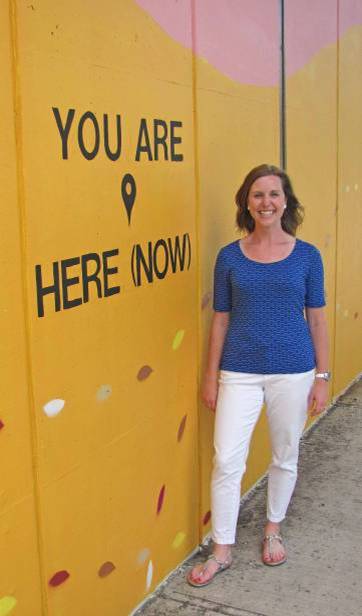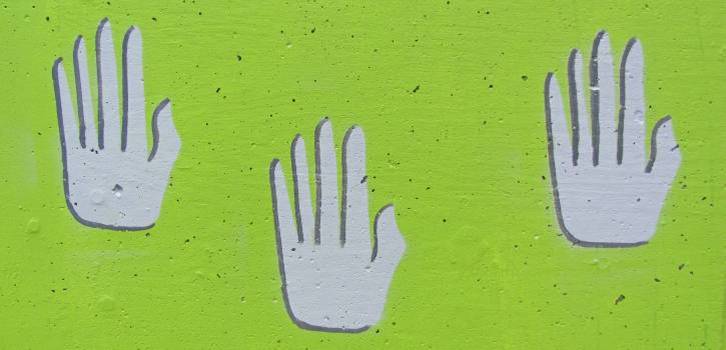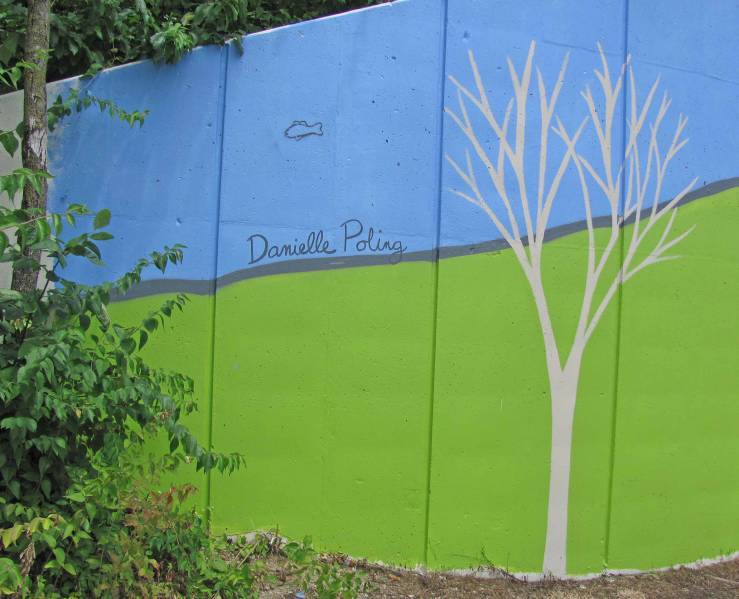 The Capitol Square Review and Advisory Board celebrates National Arts & Humanities Month in October with an artist talk featuring Danielle Poling — the artist who created the Sunwall-Moonwall murals at the Cooke Road railroad overpass.
The Capitol Square Review and Advisory Board celebrates National Arts & Humanities Month in October with an artist talk featuring Danielle Poling — the artist who created the Sunwall-Moonwall murals at the Cooke Road railroad overpass.  The presentation will take place Saturday, October 11, 2014 at 1 p.m. in the Governor Thomas Worthington Center at the Ohio Statehouse. This event is free and open to the public. I asked Danielle how she came up with the inspiration for these murals and what they mean to her. This was her answer: Mary Rodgers, the president of the Clintonville Historical Society, responded to an inquiry that I put out. I was looking for opportunities to paint large-scale murals with themes around education, literacy, history, empowerment, etc. Mary Rodgers asked if I had any ideas for a Native American Indian theme, because she felt it was an important part of Clintonville’s history, and because the North Broadway Murals showcase the history since the area was settled by Europeans. Mary Rodgers has helped make these murals a reality by vetting them with the community and with all of the logistics surrounding fundraising, city approvals and permits. The Sunwall-Moonwall murals symbolically show artifacts and earthworks (mounds) from ancient civilizations that lived here in Ohio. A noteworthy mound was excavated in the 1950s, only a couple blocks from the mural site in Clintonville. It was part of the Dominion Land Company Site and it dates back to the Early Woodland time period. The pottery archaeologists found in the mound is among the oldest pottery known in Eastern North America. So it felt right to honor that rich history with this mural.
The presentation will take place Saturday, October 11, 2014 at 1 p.m. in the Governor Thomas Worthington Center at the Ohio Statehouse. This event is free and open to the public. I asked Danielle how she came up with the inspiration for these murals and what they mean to her. This was her answer: Mary Rodgers, the president of the Clintonville Historical Society, responded to an inquiry that I put out. I was looking for opportunities to paint large-scale murals with themes around education, literacy, history, empowerment, etc. Mary Rodgers asked if I had any ideas for a Native American Indian theme, because she felt it was an important part of Clintonville’s history, and because the North Broadway Murals showcase the history since the area was settled by Europeans. Mary Rodgers has helped make these murals a reality by vetting them with the community and with all of the logistics surrounding fundraising, city approvals and permits. The Sunwall-Moonwall murals symbolically show artifacts and earthworks (mounds) from ancient civilizations that lived here in Ohio. A noteworthy mound was excavated in the 1950s, only a couple blocks from the mural site in Clintonville. It was part of the Dominion Land Company Site and it dates back to the Early Woodland time period. The pottery archaeologists found in the mound is among the oldest pottery known in Eastern North America. So it felt right to honor that rich history with this mural. Art means different things to different people. But for me, art is about making connections. We can all connect with the Sun and the Moon. Day and Night. Were not very different from the people that lived here thousands of years ago. We can see by what theyve left behind, that they collected water, they understood farming and horticulture, they observed and tracked the Moon, the Sun, the stars. They understood the spirituality within the circle of life and how imagery of animals can be metaphorical. “YOU ARE HERE (NOW)” references the language on maps, saying You are Here. I played with the meaning of the word, HERE which normally refers to location. Adding the word now changes the meaning, to refer to present time. Often historical murals have a timeline, but a timeline felt too Western for this artwork. I wanted these murals to feel the way the artifacts feelprimitive and authentic yet researched and methodical. “YOU ARE HERE (NOW)” gets to that connectedness with our past, present and future. What are we going to do with our lives? How will our choices affect future generations?
Art means different things to different people. But for me, art is about making connections. We can all connect with the Sun and the Moon. Day and Night. Were not very different from the people that lived here thousands of years ago. We can see by what theyve left behind, that they collected water, they understood farming and horticulture, they observed and tracked the Moon, the Sun, the stars. They understood the spirituality within the circle of life and how imagery of animals can be metaphorical. “YOU ARE HERE (NOW)” references the language on maps, saying You are Here. I played with the meaning of the word, HERE which normally refers to location. Adding the word now changes the meaning, to refer to present time. Often historical murals have a timeline, but a timeline felt too Western for this artwork. I wanted these murals to feel the way the artifacts feelprimitive and authentic yet researched and methodical. “YOU ARE HERE (NOW)” gets to that connectedness with our past, present and future. What are we going to do with our lives? How will our choices affect future generations?  The Sunwall-Moonwall murals remind us that we all share the same Moon. We all share the same Sun. We all share the same Earth. We may come and go, but were all connected. These are wonderful sentiments and as appropriate for Archaeology Month as they are for National Arts & Humanities Month! Brad Lepper
The Sunwall-Moonwall murals remind us that we all share the same Moon. We all share the same Sun. We all share the same Earth. We may come and go, but were all connected. These are wonderful sentiments and as appropriate for Archaeology Month as they are for National Arts & Humanities Month! Brad Lepper